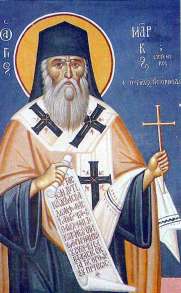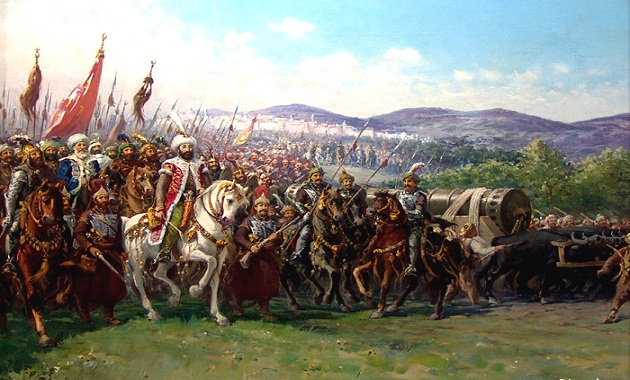An Ottoman Volunteer Defends Besieged Constantinople (1453)
29 May 2023
At the fall of Constantinople, in 1453, it was not only Greeks pitched against Turks, as is, perhaps, widely believed, but there was also a good number of foreigners involved. Some of these were forced to fight on the side of the Ottomans, such as an attachment of Serbs sent by the despot of medieval Serbia, Đurađ Branković, who was a subject of the Ottomans. Others again, such as Orban, the Hungarian (or Rumanian) canon maker, joined the Ottomans on the expectation of making a profit (Orban was richly rewarded for the construction of the massive bombard which the Turks used during the siege and which was trained, for the most part, on the gate of Saint Romanos). Most of the foreigners, however, were in the opposing camp, on the side of the Byzantines. It is well known that close to or within Constantinople lived many foreigners, mainly Italians, who maintained commercial interests in the City. They were inevitably obliged to take part in its defence, in order to preserve their favoured trading position. Among these were people from Venice, Ancona, and Catalonia, while the Genoese, who had under their control the neighbouring suburb of Peran (today’s Galata) maintained a favourable stance towards the Constantinopolitans after the beginning of the final siege.
Some foreigners came to Constantinople as volunteers on the side of the defenders, in order to take part in operations in a “crusading spirit”, either from opportunism or in the expectancy of some vague profit. The best known among them was the conditiere Giovanni Giustianini Longo, head of a mercenary body of 700 heavy cavalry who formed the “strike force” of the defenders. Also among them were the three Bocciardi brothers, at the head of a smaller force, who are charged with the misfortune of the Kerkoporta[1], which was in the part of the walls they were defending. Indicative of the importance which Konstantinos Palaiologos attached to the participation of foreign volunteers to his defence is the fact that he appointed Longo protostrator (general-in-chief) and promised to give him the island of Limnos if the Ottomans were finally repulsed, while he tasked other volunteers with the defence of particular portions of the walls. Among these, four distinguished Venetians undertook the defence of the corresponding main gates in the land walls, receiving from Konstantinos Palaiologos the keys that went with them. According to an eye-witness of the siege, the emperor confessed that Constantinople now belonged more to the Venetians than it did to the Byzantines.
But the most unlikely case among the foreign volunteers was certainly that of the Ottoman prince Orhan, concerning whom information is limited and vague. The prince was a distant relative of Mehmed II, according to one view his second cousin. According to this genealogical approach, Orhan was the grandson of Süleyman Çelebi, the elder brother of Sultan Mehmed I (1413-21). The two brothers, and, indeed, a third, Musa, had come to the Ottoman throne in succession after the unexpected capture of their father Bayezid I by Tamburlaine at the battle of Ankara. As a result of the unfortunate outcome of the battle for the Ottomans, their state fell into the maelstrom of a protracted civil war. First to seize the throne was Süleyman (1403-11), who was, however, deposed and killed by his warlike brother Musa, who, in his turn governed for two years (1411-13). His hostile intentions towards the Byzantine Empire resulted in the then emperor Manouil II Palaiologos urging the third, surviving brother Mehmed, to revolt and it was the latter who eventually triumphed.
During the unfolding of these events, the descendants of Süleyman found refuge in “neutral” Constantinople, where the Byzantines kept them, in order to use them as “a counterbalance”, provoking civil war in the Ottoman state when conditions permitted. (The Ottomans had done precisely the same thing to the Byzantine Empire in the second half of the 14th century, reinforcing various scions of the Palaiologos dynasty in their ambitions to seize the imperial throne). Prince Orhan lived in Constantinople under these conditions from his childhood. Indeed, rather than have him leave the city, Sultan Murat II, the father of Mehmed II had agreed to pay the Byzantines a bounty of 3,000 aspra[2] from the revenues from the towns along the southern stretch of the River Strymon.
By an irony of fate, the failure to pay this sum was the spark that ignited the hostilities which led to the fall of Constantinople. On his ascent to the throne, in February 1441, Mehmed II had undertaken to continue these payments, but, by the autumn of that year had still not done so, since he was engaged in putting down a rebellion in his lands in Asia Minor. Konstantinos Palaiologos deemed that this concatenation of circumstances was propitious for a show of strength and threatened Mehmed that, unless he sent the monies, the Byzantines would free Prince Orhan. This lack of diplomatic foresight on his part was to prove fatal, providing the Ottoman sultan, as it did, with the excuse he was looking for to begin the war.
At the beginning of the siege, Prince Orhan volunteered to undertake, with is own men, the defence of part of the walls, a particularly honourable action, especially when contrasted with the attitude of many of the residents of the city, who opted to follow the flow of events passively. He was therefore tasked with guarding part of the walls of Propontis, including the harbour of Eptaskalio. This part of the walls was defended bravely on the few occasions when the Ottoman fleet attempted to create a diversion for the defenders from the side of Propontis. At the entry of the invaders into Constantinople, according to Runciman, Prince Orhan and his Turks continued to fight, knowing full well the fate that awaited them if they fell into the hands of the sultan (The Fall of Constantinople, p. 211).
The fall sealed his own fate, however. All sources report that he was killed, though they do not agree on the precise manner of his death. According to Laonikos Halkokondylis (book VIII), he committed suicide by jumping off a tower to avoid capture, having previously disguised himself as a monk. Kritovoulos (book I, chap 64, paras. 1-2) asserts that he disguised himself as an ordinary soldier and attempted to escape by using his knowledge of Turkish, but was recognized and committed suicide by jumping off the wall. Thereafter, Turkish soldiers cut off his head and took it to Mehmed. Finally, according to Doukas (chap. XL, para. 4), who was in Constantinople shortly after the fall, and doubtless collected verbal testimony, he was betrayed to Admiral Hamza Bey by a prisoner (in exchange for his own freedom), having already been captured trying to escape from the gate “of the Franks” disguised as a monk. Thereafter he was beheaded by him.
Mehmed benefited twice over from the death of Orhan: not only did he capture “the queen of cities” but also rid himself of the only living contender for his throne. The brief military career of the rather unknown Ottoman prince, however, places him among history’s more interesting oddities.
Bibliography:
Sir Steven Runciman, The Fall of Constantinople. CUP, 1965.
Franz Babinger, Mehmed the Conqueror and his Time, Princeton University Press, 1978.
The texts by Laonikos Halkokondylis, Kritovoulos and Doukas concerning the fall are available in Modern Greek with the common title Βυζαντίου Άλωσις, published by editions Δημιουργία, Athens 1997, 1999 and 2000 respectively. The Halkokondylis text is also available in a second edition from editions Αντώνη Σταμούλη, Thessaloniki, 2006.
[1] According to the historian Doukas, on the morning of 29 May 1453, a small postern known as Kerkoporta was left open by accident, allowing the first Ottoman troops to enter the city. (trans. note)
[2] A silver-wash bronze coin (trans. note)
https://pemptousia.com/2023/05/an-ottoman-volunteer-defends-besieged-constantinople-1453/


